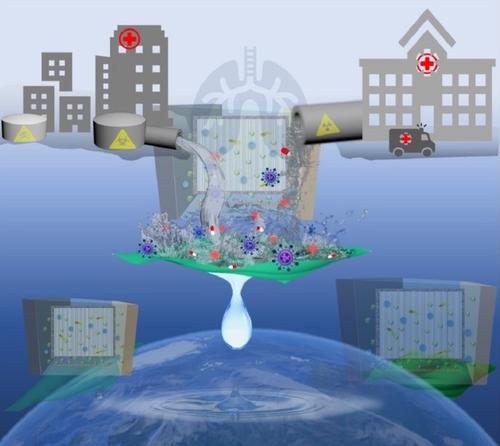Frontiers of Chemical Science and Engineering ( IF 4.3 ) Pub Date : 2021-11-26 , DOI: 10.1007/s11705-021-2107-1 Yan Zhao 1 , Yangbo Qiu 2 , Natalie Mamrol 3 , Longfei Ren 2 , Xin Li 1 , Jiahui Shao 2 , Xing Yang 1 , Bart van der Bruggen 1

|
Discharged hospital wastewater contains various pathogenic microorganisms, antibiotic groups, toxic organic compounds, radioactive elements, and ionic pollutants. These contaminants harm the environment and human health causing the spread of disease. Thus, effective treatment of hospital wastewater is an urgent task for sustainable development. Membranes, with controllable porous and nonporous structures, have been rapidly developed for molecular separations. In particular, membrane bioreactor (MBR) technology demonstrated high removal efficiency toward organic compounds and low waste sludge production. To further enhance the separation efficiency and achieve material recovery from hospital waste streams, novel concepts of MBRs and their applications are rapidly evolved through hybridizing novel membranes (non hydrophilic ultrafiltration/microfiltration) into the MBR units (hybrid MBRs) or the MBR as a pretreatment step and integrating other membrane processes as subsequent secondary purification step (integrated MBR-membrane systems). However, there is a lack of reviews on the latest advancement in MBR technologies for hospital wastewater treatment, and analysis on its major challenges and future trends. This review started with an overview of main pollutants in common hospital waste-water, followed by an understanding on the key performance indicators/criteria in MBR membranes (i.e., solute selectivity) and processes (e.g., fouling). Then, an in-depth analysis was provided into the recent development of hybrid MBR and integrated MBR-membrane system concepts, and applications correlated with wastewater sources, with a particular focus on hospital wastewaters. It is anticipated that this review will shed light on the knowledge gaps in the field, highlighting the potential contribution of hybrid MBRs and integrated MBR-membrane systems toward global epidemic prevention.
中文翻译:

用于医院废水处理的膜生物反应器:膜和工艺的最新进展
排放的医院废水含有各种病原微生物、抗生素类、有毒有机化合物、放射性元素和离子污染物。这些污染物危害环境和人类健康,导致疾病传播。因此,有效处理医院废水是可持续发展的紧迫任务。具有可控多孔和无孔结构的膜已被迅速开发用于分子分离。特别是,膜生物反应器(MBR)技术表现出对有机化合物的高去除效率和低废污泥产量。为了进一步提高分离效率并实现医院废物流的材料回收,MBR 的新概念及其应用通过将新型膜(非亲水性超滤/微滤)与 MBR 单元(混合 MBR)或作为预处理步骤的 MBR 以及集成其他膜工艺作为后续二级纯化步骤(集成 MBR-膜系统)。然而,缺乏对医院废水处理 MBR 技术最新进展的评论,以及对其主要挑战和未来趋势的分析。本综述首先概述了普通医院废水中的主要污染物,然后了解了 MBR 膜(即溶质选择性)和工艺(例如污垢)的关键性能指标/标准。然后,深入分析了混合 MBR 和集成 MBR 膜系统概念的最新发展,以及与废水源相关的应用,特别关注医院废水。预计这篇综述将阐明该领域的知识空白,突出混合 MBR 和集成 MBR 膜系统对全球防疫的潜在贡献。









































 京公网安备 11010802027423号
京公网安备 11010802027423号